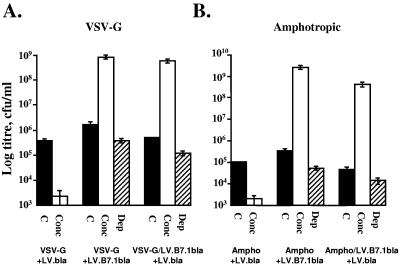FIG. 2.
B7.1-dependent capture of lentiviral vectors. Lentivirus was produced from 293T cells by transient transfection of helper functions with either LV.bla vector plasmids (VSV-G+LV.bla and Ampho+LV.bla) or B7.1-encoding LV.B7.1bla vector plasmids (VSV-G+LV.B7.1bla and Ampho+LV.B7.1bla). Alternatively 293T cells expressing B7.1 from a prior infection with the self-inactivating B7.1 vector (VSV-G/LV.B7.1bla and Ampho/LV.B7.1bla) were transfected with LV.bla to result in VSV-G/LV.B7.1bla+LV.bla and Ampho/LV.B71bla+LV.bla. The lentiviral affinity for CTLA4-Ig-conjugated PMP was thus examined for vectors derived from B7.1-negative 293T cells and compared with those derived from 293T cells expressing either transient or integrated stable B7.1. Titers of VSV-G-pseudotyped or amphotropic lentiviral vector supernatants were determined on K562 cells (4 μg/ml Polybrene), either immediately without concentration (C) or following capture and 100-fold concentration with CTLA4-Ig-conjugated PMP (Conc). The remaining supernatant following removal of the PMP (Dep) was used to infect target cells as an estimate of capture efficiency.

